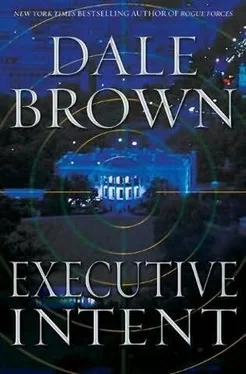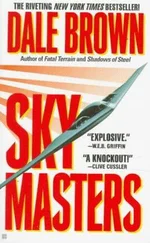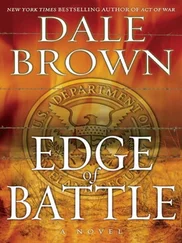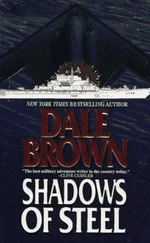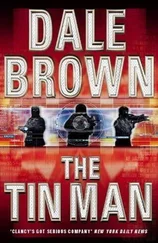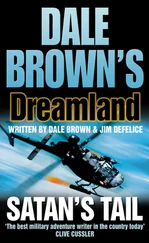But this was not a land-attack ballistic-missile experiment. The JL-1 did not adopt a ballistic flight path, but instead continued almost straight up, punching through the atmosphere at several thousand miles per hour. Five minutes after blasting through the surface of the South China Sea, the JL-1 flew into the path of a Chinese Fengyun FY-1D weather satellite, orbiting 320 miles above Earth, and destroyed it with a high-explosive cloud of shrapnel.
OFFICE OF THE SECRETARY OF DEFENSE, THE PENTAGON, WASHINGTON, D.C.
A SHORT TIME LATER
“They scored a bull’s-eye, sir,” Kai Raydon said on the secure video teleconference link, “and put us square in their crosshairs at the same time.”
“Let’s not be so dramatic here, General Raydon,” Secretary of Defense Miller Turner said. With him in his office was the secretary of the Air Force, Sal Banderas; Ann Page, undersecretary of the Air Force for space; and Chairman of the Joint Chiefs of Staff General Taylor Bain. Also in on the teleconference was Admiral Sherman Huddy, commander of U.S. Strategic Command, from his temporary command center at Battle Mountain Air Force Base in Nevada; and General Robert Wiehl, commander of U.S. Space Command, from his headquarters at Peterson Air Force Base in Colorado, along with several analysts and advisers from around the world. “Every Chinese missile test isn’t a direct threat to us.”
“Sir, it was an antisatellite missile launched from a submerged submarine,” Ann Page said. “The DF-21s were a big enough threat, but at least we could see where they were placed and target them, even the mobile units. The sub-launched ones can be anywhere. The land-based missiles have a range of about fifteen to nineteen hundred miles, but in antisatellite mode the sub can be positioned within a thousand miles of a satellite’s path and be able to hit it in almost any orbital inclination. It’s a radical new capability that poses a direct threat not only to Armstrong, but to all American space assets.”
“All right, Secretary Page, you made your point,” Turner said, holding up a hand. “But let’s get some perspective here, shall we? First of all: Do we know it was a direct hit?”
“As far as we can measure, sir,” General Wiehl replied. “It’s possible they could have faked the hit. But the satellite they destroyed was a weather satellite that we’ve been tracking for many years.”
“We have some pretty clear electro-optical pictures of the engagement-it looks like a direct hit to us, sir,” Kai chimed in.
“Let’s say it was a direct hit,” Turner said. “In that case: good show. But let’s put this in some perspective, shall we? We were similarly surprised when the Chinese shot down their other weather satellite back in 2007, but this is the first ASAT test since then, am I correct?”
“Yes, sir,” Wiehl replied.
“So two successful ASAT tests in five years? Not exactly a grave threat to national security, I’d say. Next: The Chinese have how many subs capable of launching a JL-1 missile?”
“Eight, sir,” Admiral Huddy replied after checking his notes, “with two more nuclear-powered boomers in the works. But there are only four Xia-class subs active now-the other four Jin-class subs are designed to carry the larger JL-2 missiles for intercontinental ballistic-missile duties.”
“So you’re saying just four subs capable of launching ASATs?” Turner asked. “How many missiles per sub?”
“Twelve, sir.”
“And normally only two subs are at sea at a time? That’s true for us, right, so it must be true for the Chinese?”
“Yes, sir. They could surge them in times of crisis, as we would, but half on patrol and half in training, predeployment workup, or maintenance is typical.”
“So we’re down to two subs on duty with a max of twenty-four ASATs. It doesn’t sound like much of a threat to me, ladies and gentlemen.”
“Combined with the land-based antisatellite missiles, I’d say it was a very serious threat, especially in a coordinated attack against Armstrong, sir,” Kai said. “They would salvo their ASATs to try to overwhelm our defenses, dilute the number of interceptors we could use for antiballistic-missile defense, and put us on the defensive to prevent us from employing ground-attack weapons.”
“And if they load up their subs with antisatellite missiles they have fewer land-or ship-attack weapons to use against someone else,” Turner said. “The president warned about an arms race, folks, and it looks like it’s happening right before our eyes. We spooked the Chinese by firing antiballistic-missile and ground-attack weapons from space, and now they’re scrambling to make up for lost ground.”
“The good news is, they’re forced to compromise other plans and programs to do so,” General Bain said.
“Only until they ramp up production and build more subs and missiles, sir,” Kai said.
“Which they certainly will,” Ann Page interjected. “So I believe it’s imperative to start ramping up our own space programs, such as deploying the remaining interceptor garages quicker and completing the network integration of Space Defense Force with the other services, the Pentagon, and the intelligence services. We know now that if we do nothing, the Chinese are very capable of quickly fielding a potent enough mix of weapons to seriously threaten our foothold in space. We need to deploy the remaining twenty-four garages as soon as possible. With the right funding, we can-”
“You’re talking money that’s not in the budget now and is not expected to be in the budget for the next three to seven years, Ann,” Turner said. “We’re spending billions to launch things into space that cost the Chinese only a few million to kill. That kind of fuzzy math is not going to solve the problem.” He turned away from Ann to the chairman of the Joint Chiefs. “General, what’s the conclusion of the Chiefs? Is this a real threat against our space assets, a warning message, or a successful demonstration that isn’t a real threat to us?”
“The Chiefs had the same questions you did about the numbers of ballistic-missile-capable subs in the Chinese fleet and the number of ASAT tests over the years, sir,” General Bain replied, “and they have concluded that the test was indeed very impressive, but the threat to Armstrong Space Station or any other assets would be minimal.
“True, the Chinese have deployed many of these ground-based mobile antisatellite emplacements in recent months,” he went on, “and the submarine-launched ASAT is a much greater threat because it would be harder to target ahead of time.” He looked at Ann Page, nodded, and spread his hands. “And frankly, I’m not on Armstrong, looking down the barrel of all those guns pointed at me. But the United States has declared that attacking any space assets would be treated the same as attacking sovereign American soil or a U.S.-flagged ship at sea, and the Chiefs don’t believe China wants to attack anyone.
“The bottom line is this, sir: China has deployed an awful lot of these ASAT sites in direct proportion to our deployment of these interceptor garages in space,” Bain concluded. “Those garages are there not to start a fight, but to respond in case a fight breaks out. We feel the same is true for the ASAT sites. Further, China is deploying these weapons with way below the bare minimum of testing. We looked at the same info: Two tests in five years, although successful, do not normally signal a green light to widely deploy these systems. China is doing this in response to our actions, whether or not the weapons are truly effective. They are trying to show they can’t be bullied or intimidated.”
“But we’re not trying to bully or intimidate anyone here,” Turner said, “so China is setting up these antisatellite weapons for nothing. It’s a waste of their time and money.”
Читать дальше
